The Myth of Head versus Heart
Sadhguru breaks the head versus heart myth, and explains that they are different manifestations of the same source.

బుద్ధి చెప్తోంది కాని మనస్సు వినట్లేదు – నిజమా??
Sadhguru: It is common to hear people say that their head leads them in one direction and their heart in another. In yoga, the fundamental basis we establish is this: you are one person, a single, unified being. There is no separation of head and heart; you are one whole.
Let us first understand what is being referred to as the “head” and the “heart.” You usually assign your thoughts to the head and your emotions to the heart. But if you look at this carefully and with absolute sincerity, you will realize that the way you think is the way you feel. But it is also true that the way you feel is the way you think. This is why yoga includes both thought and emotion as part of the same manomayakosha, or mental body.
What you normally think of as “mind” is the thought process or intellect. But in fact, the mind has many dimensions: one is the logical aspect. Another is the deeper emotional aspect. The intellect, as we know, is termed buddhi. The deeper dimension of the mind is conventionally known as the heart. But in yoga this deeper emotional mind is known as manas. Manas is a complex amalgam of memory that molds emotions in a particular way. So, the way you feel and the way you think are both activities of the mind.
Subscribe
For example, if I think you are a wonderful person, I will have sweet emotions toward you. If I think you are a horrible person, I will harbor nasty emotions about you. If you make someone your enemy and then try to love him or her, that is hard work. Let us not make hard work of the simple aspects of life.
The way you think is the way you feel, but thought and feeling seem to be different in your experience. Why is this so? Because thought has a certain clarity and agility about it. Emotion is slower. For example, if today, you think this is a very wonderful person and you have warm feelings about him. Suddenly, he does something that you don’t like, and you think he is horrible. Your thought tells you he is horrible, but your emotion cannot change immediately. It struggles. If it is sweet now, it cannot turn bitter at the very next moment. It takes time to turn around. It has a wider turning arc. Depending on the strength of your emotion, maybe it will take three days or three months or three years, but after some time, it will turn around.
There is no need to create this conflict between head and heart. Emotion is just the juicier part of thought. You can enjoy its sweetness, but it is largely thought that leads the emotion, whether you recognize it or not. Emotion is not entirely steady. Your emotion also chatters, goes this way and that, but it is less agile than thought. Since it takes longer to turn, and its intensity is usually substantially greater than thought, it often seems as though thought and emotion are different. But they are no more separate than sugarcane and its juice.
Thought is not as intense as emotion in most people’s experience. (You usually do not think as intensely as you get angry, for instance.) But if you generate an intense enough thought, it can also overwhelm you. Only five to ten percent of the population may be capable of generating the kind of thought that is so intense that there is no need for emotion. Ninety percent of the population can only generate intense emotions because they have never done the necessary work in the other direction. But there are people whose thought is very deep. They don’t have much emotion, but they are very deep thinkers.
It is best not to create polarities within yourself. That makes for civil war and schizophrenia. Thought and feeling are not different. One is dry. Another is juicy. Enjoy both.
Editor's Note: "Inner Engineering: A Yogi's Guide to Joy" by Sadhguru is now available for purchase in US, UK and in India. Order your copy now!


